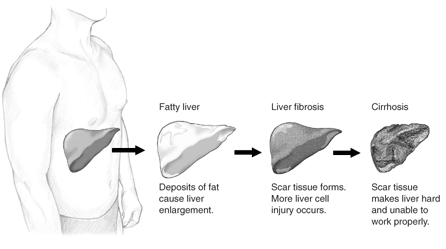
The liver has a number of vital bodily functions involving the metabolism of energy by the muscles, the digestion of fats, and production of a large number of enzymes necessary to controlled activity. These functions can fail due to several different progressive liver diseases, as well as traumatic damage to the liver itself.
When the liver damage is due to a chronic disease, it proceeds through phases. When the disease is cirrhosis of the liver, the stages are mapped out by medicine, each one identifying an increased level of liver malfunction.
Other progressive diseases of the liver such as liver cancer do not follow precisely the same progression as cirrhosis, but do show the same overall progression from no symptoms of liver dysfunction to full breakdown and mortality.
Alcoholism And Alcohol Abuse
Alcohol abuse is one of the main causes of liver damage. Other causes certainly do exist, such as obesity and diabetes, or complications from certain medications, but alcohol abuse is probably the single most common reason why the liver breaks down. Most liver diseases are divided into an alcoholic and a non-
Cirrhosis
In the first stage of cirrhosis, there are usually no symptoms, and liver functioning isn’t measurably impaired. The disease shows up in blood tests only.
The second stage of cirrhosis involves the formation of scar tissue into fibrous masses. This syndrome is called “fibrosis” and it can exist as a liver disease in itself, without a diagnosis of cirrhosis. In the second stage, liver functioning begins to be impaired to the point of producing some symptoms, such as jaundice, fatigue, nausea, vomiting, and swelling of different parts of the body.
In the third stage of cirrhosis, the pockets of fibrotic tissue join together into larger masses, significantly impairing liver functioning. The fourth and fifth stages of cirrhosis involve more and more replacement of healthy liver tissue by scar tissue, until in the fifth stage liver functioning has been reduced to the point where it all or nearly nonexistent, and the prognosis is terminal.
Liver Cancer
The progression of liver cancer is different from that of cirrhosis, but the end result is the same. The cancerous tissue absorbs more and more of the blood and nutrition that would otherwise go to support the liver itself, and liver functioning declines to the point of nullity. As an added complication, cancer of the liver can metastasize –
in origin. That is, the cancer may have arisen elsewhere in the body and seeded itself to the liver.
Liver Transplant
When liver function has declined to the point where the organ can no longer do its job, the prognosis is always terminal. There is no way for the damage to be repaired. A liver transplant can restore liver functioning by transplanting a healthy liver to replace the diseased one. The procedure is extremely complicated and normally requires three surgeons with supporting staff. Prognosis with a successful transplant is quite good; patients have a 58% chance of surviving for 15 years or more.